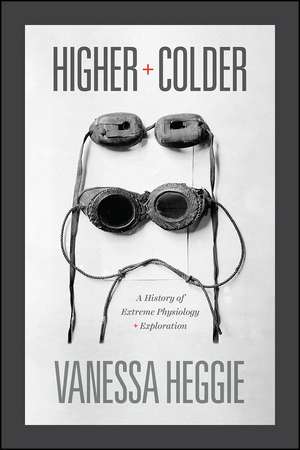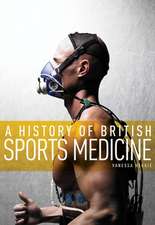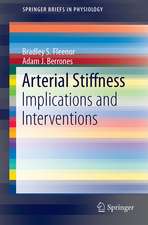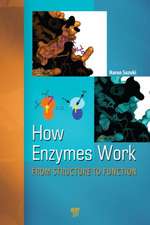Higher and Colder: A History of Extreme Physiology and Exploration
Autor Vanessa Heggieen Limba Engleză Hardback – 19 sep 2019
During the long twentieth century, explorers went in unprecedented numbers to the hottest, coldest, and highest points on the globe. Taking us from the Himalaya to Antarctica and beyond, Higher and Colder presents the first history of extreme physiology, the study of the human body at its physical limits. Each chapter explores a seminal question in the history of science, while also showing how the apparently exotic locations and experiments contributed to broader political and social shifts in twentieth-century scientific thinking.
Unlike most books on modern biomedicine, Higher and Colder focuses on fieldwork, expeditions, and exploration, and in doing so provides a welcome alternative to laboratory-dominated accounts of the history of modern life sciences. Though centered on male-dominated practices—science and exploration—it recovers the stories of women’s contributions that were sometimes accidentally, and sometimes deliberately, erased. Engaging and provocative, this book is a history of the scientists and physiologists who face challenges that are physically demanding, frequently dangerous, and sometimes fatal, in the interest of advancing modern science and pushing the boundaries of human ability.
Unlike most books on modern biomedicine, Higher and Colder focuses on fieldwork, expeditions, and exploration, and in doing so provides a welcome alternative to laboratory-dominated accounts of the history of modern life sciences. Though centered on male-dominated practices—science and exploration—it recovers the stories of women’s contributions that were sometimes accidentally, and sometimes deliberately, erased. Engaging and provocative, this book is a history of the scientists and physiologists who face challenges that are physically demanding, frequently dangerous, and sometimes fatal, in the interest of advancing modern science and pushing the boundaries of human ability.
Preț: 260.57 lei
Preț vechi: 274.28 lei
-5% Nou
Puncte Express: 391
Preț estimativ în valută:
49.87€ • 54.15$ • 41.89£
49.87€ • 54.15$ • 41.89£
Carte disponibilă
Livrare economică 02-16 aprilie
Livrare express 18-22 martie pentru 33.20 lei
Preluare comenzi: 021 569.72.76
Specificații
ISBN-13: 9780226650883
ISBN-10: 022665088X
Pagini: 264
Ilustrații: 13 halftones
Dimensiuni: 152 x 229 x 25 mm
Greutate: 0.5 kg
Ediția:First Edition
Editura: University of Chicago Press
Colecția University of Chicago Press
ISBN-10: 022665088X
Pagini: 264
Ilustrații: 13 halftones
Dimensiuni: 152 x 229 x 25 mm
Greutate: 0.5 kg
Ediția:First Edition
Editura: University of Chicago Press
Colecția University of Chicago Press
Notă biografică
Vanessa Heggie is a lecturer in the history of medicine and science at the Institute of Applied Health Research at the University of Birmingham. She is the author of A History of British Sports Medicine and was coauthor of the Guardian blog The H-Word from 2012 to 2017.
Cuprins
List of Abbreviations
One / Introduction: Higher and Colder
Two / Gasping Lungs
Three / Frozen Fields
Four / Local Knowledge
Five / Blood on the Mountain
Six / Conclusion: Death and Other Frontiers
Acknowledgments
Notes
Bibliography
Index
One / Introduction: Higher and Colder
Two / Gasping Lungs
Three / Frozen Fields
Four / Local Knowledge
Five / Blood on the Mountain
Six / Conclusion: Death and Other Frontiers
Acknowledgments
Notes
Bibliography
Index
Recenzii
"Higher and Colder will prove essential reading for historical geographers working on histories of expeditions, travel and field science, and useful for any scholar interested in the relationships between place and the production of knowledge. It raises provocative questions about why for over a century, some researchers have been willing to put human bodies – their own and others' – at risk in the pursuit of science."
"Heggie’s much-anticipated history of 'extreme physiology' does not disappoint. Higher and Colder takes historians of twentieth-century biology and medicine on a journey well beyond specific diseases and beyond laboratory walls to 'whole-body physiology'—a highly networked, multisited, field-based biological science. . . . The genius of Higher and Colder is its organization. What could have been just a chronological narrative of adventurous European men over time is instead a series of chapters that tackle crucial themes in the history of twentieth-century biology: gender and expertise, military and industrial competition, imperialism and indigeneity, and epistemologies of difference. . . . Heggie’s thematic organization helps transcend the constraints of her source material, again pushing the history of physiology in welcome directions. . . . The empirical details, careful insights, and bold arguments of Higher and Colder are immediately valuable, not only for historians of twentieth-century biology and medicine but also for environmental historians, labor historians, and historians of technology."
"Extreme physiology remains an important aspect of study as we set our sights ever outward (to polar regions), upward (to the Moon and Mars), and downward (to the deep ocean). With Higher and Colder, Heggie reminds us that such work can offer extraordinary stories about how science is practiced while challenging the scientific community to consider adopting institutional changes that ensure that everyone can participate and is recognized for their contributions."
"Heggie aims high and succeeds in mastering a huge topic and presenting a very dense but highly readable text. Furthermore, she stirs new research questions for bodies in the wilderness and exploration medicine, psychological fieldwork, the nexus between indigenous non-temperate bodies and evolutionary theory cum racial science, and lastly, the history of homeostasis. Looking at bodies in crisis or bodies under extreme conditions adds to a specific twentieth-century notion of homeostatic bodies. In Higher and Colder, the mostly utterly abstract history of homeostasis reaches ground level and takes the shape of everyday gadgets and truly felt limitations of human bodies."
"An excellent historical backdrop to extreme physiology research, this well-documented text will be of considerable interest to wilderness travelers and a new generation of biomedical researchers. . . . Recommended."
"Heggie has produced an innovative and stimulating contribution to the history of science with her investigations into extreme physiology and exploration. . . . She takes the reader out of the laboratory and into the real world to show how our understandings about the effects of extreme environments upon explorers were many times learned the hard way—on the mountain tops and across the Arctic ice, often with dire consequences. . . . Heggie’s close examination of the history of extreme physiology thus adds to a wealth of fascinating stories about how scientists have lived and died in the most challenging environments in order to advance their scientific knowledge and experience the thrill of adventure. . . . [She] admirably convinces us that the field as a location of science in action has been marginalized and does indeed deserve study as a site of scientific activity in its own right."
"Through a series of thematic chapters, Heggie shows how biomedical scientists investigated the physical effects of exposure to extreme environments, while also developing (or appropriating) technologies and behavioral strategies that could mitigate them. . . . Heggie stays close to her sources, providing a fine-grained analysis of specific expeditions, experiments, or technologies. . . . Higher and Colder, then, not only speaks to broader themes in the history of biology, but also raises new questions and potential avenues of inquiry for historians of the life and environmental sciences."
"Heggie takes fieldwork 'out of the shadow of the laboratory', while also highlighting the functional relationship rather than the conflict between the laboratory and field. The focus on extreme physiology is particularly fruitful for such an approach. . . . Higher and Colder is an excellent and well-written book, which will be of great value to anyone interested in exploration and medical research, as well as the material culture of science more generally. . . . No doubt, Heggie's book will become a staple work for historians to use in the years to come."
"I love this book. With its focus on biomedical research in extreme environments, Higher and Colder shows how twentieth-century expeditions—to the Arctic, the Antarctic, and the Himalayas—are stranger than we thought. This story of exploration plays out on ice caps and mountaintops, but also in places not often sketched on the expeditionary map: inside barometric chambers, scientific outposts, and medical laboratories. Heggie examines the tangible and visceral aspects of expeditionary work—blood, food, clothing, equipment—in order to challenge our basic assumptions about the history of expeditionary science: that we know what it is and how it gets done."
"A gripping and revelatory story of the physiologists who went to extremes in the twentieth century as they charted the parameters of human performance in some of the globe’s most inhospitable places. Heggie reveals how these researchers trekked to the tops of mountains and the earth’s icy poles, curious less about these extraordinary environments than the inner workings of human physiology. The world was their laboratory. Higher and Colder likewise explores the complex colonial, military, cultural, and political terrain that framed this style of expeditionary biomedical science. The book makes a significant contribution to the history of the field sciences, environmental history, and the history of twentieth-century medicine."
“Vanessa Heggie brings to vivid life the history of the sciences of human survival at its limits. Higher and Colder offers a bold and persuasive interpretation of exploration as a scientific practice in the twentieth century, when Mount Everest and the polar regions became natural laboratories for physiological experiments, racial ideologies, gender hierarchies, indigenous technologies, and everyday practices of exploration. Elegantly written, it provides a welcome historical perspective on the biomedical research that has saved the lives of thousands of hikers and mountaineers.”
“This book is a valuable resource. The topics have been thoroughly researched, and the documentation in notes at the end of the book is meticulous. Impressively, even with the depth of its detail, the book is a pleasure to read. Strongly recommended.”
"Heggie makes the case that in extreme physiology the field was a site of scientific authority in its own right, often exceeding or defying laboratory-based expectations."
"Heggie makes a compelling case for writing expeditions and explorations into the history of twentieth-century science... Her work provides a starting point for future studies that analyse sources beyond Australian, British and US archives in order to integrate colonial and postcolonial international politics into the history of exploration science in the twentieth century."






















